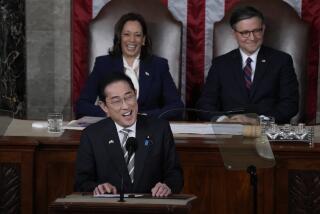Koizumiâs Budget Seen as Risky
TOKYO â Japanese Prime Minister Junichiro Koizumiâs unveiling Friday of the first budget blueprint of his young administration was an attempt to show that his reform program is more than just a slogan.
But the widely anticipated plan was immediately criticized by many economists who said it courts disaster by cutting the budget at a time when the worldâs second-largest economy is on its back.
âItâs true this cuts spending for inefficient public works,â said Tetsuro Sugiura, chief economist with Fuji Research. âBut the timing is very bad. The Koizumi Cabinet is trying to do too many things simultaneously.â
The populist Koizumi vowed Friday to cut total spending next year by 1.8%, or about $7.3 billion, and change the way spending is distributed. Once-sacred public works outlays will be slashed by 10%, as will overseas development aid, with the savings channeled into environmental programs, nursing care, education, scientific research and urban development.
Market reaction was muted, as the benchmark 225-issue Nikkei stock average fell 19.50 points, or 0.2%, to finish at 11,735.06 on Friday in advance of next weekâs traditional summer holidays.
Analysts said the budget plan, which faces debate in parliament, makes good political sense and should deter critics who have questioned Koizumiâs determination to end wasteful spending, roll back gaping deficits and reward urban voters long held hostage to rural politicking. Maintaining his strong popularity ultimately depends on convincing voters heâs different from traditional Liberal Democratic Party leaders, who have poured billions of dollars in rural pork-barrel projects.
It may make good medium-term economic sense, but the problem is the near term. Japan is undergoing deflationary pressure, economic growth is rapidly heading into negative territory, capital spending is anemic, consumer sentiment is falling and manufacturing is on the ropes. By introducing Japanâs largest budget cut at this point, the administration risks dragging the economy down by an estimated 0.3% to 0.8% when it can least afford it, analysts said.
Some also see a danger of a balloon effect.
âAs the central government cuts, local authorities will be forced to follow,â said Junichi Makino, analyst with Daiwa Research Institute. âThe result could be 400,000 lost jobs in the construction industry. His priorities are wrong.â
Economists also question the prime ministerâs vow to cap new government debt issuance at $240 billion, a move that limits maneuvering room and could drive up interest rates if conditions get much worse.
âHe should not have been so obsessive about fixing this number,â said Taro Saito, analyst at Nissei Research Institute. âHe could find himself bound hand and foot.â
But Koizumi is juggling more than Japanâs basket-case economy. He needs to make sure he survives politically to produce any results. And being seen by the public as a man of his word is arguably at least as important for him now as coddling the economy.
Koizumi was reelected president of the ruling LDP on Friday for a two-year term following a big win in the July 29 election. But he remains vulnerable to hard-liners in his own party who are strongly opposed to his economic reform plans. Underscoring the gamble Koizumi is taking as he tries to steer a course through a series of treacherous policy reefs, Japan last cut government spending in 1997 during a similarly jittery economic period. The move sparked a sharp contraction and ultimately led to the resignation of then-Prime Minister Ryutaro Hashimoto.
Japanâs economy is in such bad shape that almost any move presents risks. The country has spent more than $800 billion over the last decade trying to stimulate the economy with little to show for it. Analysts said at the very least, Koizumi is trying to break the mold and shift spending into more productive sectors of the economy.
One area Koizumi has done little to tackle, however, is Japanâs enormous banking problems and bad debts. Analysts said heâs reluctant to squander his political capital at this stage on this pressing problem.
Many Japanese, meanwhile, expressed early support Friday for Koizumiâs avowed belt-tightening.
âThe whole of Japan is suffering, and weâre just going to have to endure it,â said Toru Takeuchi, a 48-year-old construction company employee. âWe canât just sit around watching the old economy deteriorate. We need a change and some new thinking.â
Fuji Research forecasts negative economic growth of 2% for the July-September quarter, followed by flat growth at best through March despite the governmentâs official growth projections of 1.7% for this year.
Still unanswered, meanwhile, is how much average Japanese are willing to suffer if the reforms start to hurt them.
âThereâs a lot of pain out there,â said Akira Hasegawa, a 34-year-old insurance worker living in central Japan. âIâm real worried these days. But we canât rely on the government anymore. If Koizumi can start making more money flow into the private sector, I support that.â
*
Hisako Ueno in The Timesâ Tokyo bureau contributed to this report.
More to Read
Sign up for Essential California
The most important California stories and recommendations in your inbox every morning.
You may occasionally receive promotional content from the Los Angeles Times.










